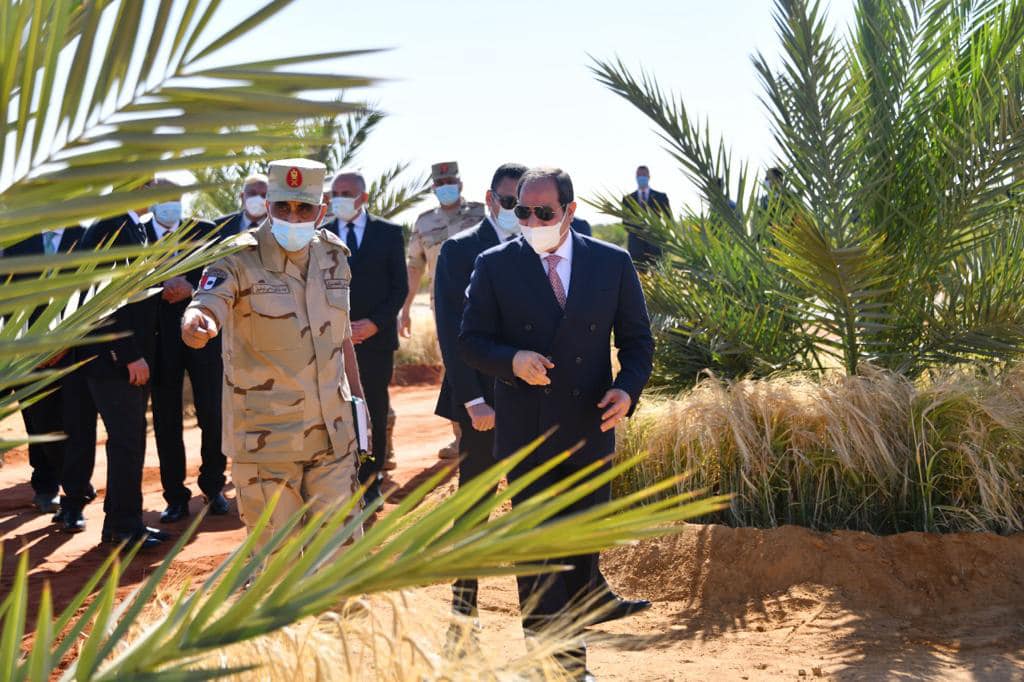CAIRO – 21 April 2022: Given its expected economic returns and significance in achieving food security for Egyptian people, the Toshka project in Upper Egypt’s Aswan was revived by President Abdel Fattah El-Sisi in 2014 to become a giant development project after two decades of futility.
The Toshka project, located in the South Valley in Aswan and believed to be the largest of its type in the region, aims at achieve self-sufficiency in wheat, a basic commodity that has been highly affected by the Russia-Ukraine crisis.
The crisis has affected the wheat supply globally, especially as the two warring countries are one of the largest wheat exporters worldwide. Egypt has depended over the past years on Russia and Ukraine for about 80 percent of its wheat imports, according to officials.

During the inauguration of the project in December, Sisi called for speedy reclamation of the Toshka lands for the possibility to produce around 500,000 tons of wheat.
According to a documentary aired during the inauguration, the project can decrease Egypt’s imports of wheat to only a quarter of total consumption.
Launching the project
The Toshka project was launched in the 1970s and faced at that time a number of obstacles that prevented its completion. The project aims to overcome the food gap by increasing the agricultural area to reach one million feddans in the future.
The project was launched during the era of Kamal Al-Ganzouri, prime minister under former President Hosni Mubarak.
The project also aims at maximizing the return on available resources and increasing agricultural exports, which helps reduce the trade balance deficit and providing job opportunities for many young people.
The project, which lies 225 kilometers south of Aswan, is set to encourage the reconstruction and relieve human pressure on the Nile Valley and Delta.
According to the Ministry of Water Resources and Irrigation, when launched, Toshka aimed at transferring water from Lake Nasser through a 200-meter-wide canal. This passes through the Toshka Depression to the Farafra Oasis.
The goal of the project when launched was to bridge the gap, which was estimated at the time at about $10 billion between production and consumption and to support the country’s national economy.
Obstacles to the project
At the time, after billions of pounds have been spent on the project, reports claimed that that what can be grown in this area only does not exceed 5 percent of the total area mentioned in the project due to many challenges facing the area.
This comes despite the large quantities of water available for it. The presence of a granite mountainous wall in the area with a length of 9 kilometers was on top of these obstacles.
This is in addition to the difficult nature of the soil that hinders the cultivation of crops in some areas, including the high soil salinity in the area, and the increase in the cost of infrastructure compared to the economic return from the project, according to reports.
During the inauguration of the project in December, Sisi said the granite wall, which interrupted the work at the project over the past years, was destroyed by three million tons of explosives.
Reviving the project
The project has suffered from neglect and mismanagement until the decision of President Abdel Fattah El-Sisi in 2014 to revive it within the state’s plan to launch a number of major projects.
The state seeks to also reclaim one million feddans within the national plan to reclaim four million feddans within 4 years.
The project comes within the framework of the state’s plan to expand the inhabited area from 5 percent to 25 percent of the area of Egypt with all the demographic, economic and social effects that it entails.
The Ministry of Irrigation has established the national infrastructure for the project on an area of 350,000 feddans.
Toshka is considered one of the most important national projects in the field of agriculture to provide tons of different agricultural products to the state.
The project aims to reclaim and cultivate about 600,000 feddans around the Toshka depressions. The state also aims to plant 2.5 million unique Arab date palms within the project.
During the inauguration of the project, Sisi has praised the engineering efforts in the Toshka project, saying that are not less than the efforts made to construct the $500 million Aswan High Dam.
He urged media to pay more attention to the achievements made to make the project a success.
“We are doing the impossible,” Sisi said, thanking Ganzouri for starting Toshka project.
Starting wheat harvest
Sisi made an inspection tour in Toshka agricultural lands on Thursday to witnesses the start of the wheat harvest season.
Sisi then gave the green light for the opening of some wheat silos via video in several governorates and watched a documentary on Egypt’s achievements to secure the wheat needed for local consumption.
Egypt has cultivated 217,700 feddans of agricultural lands as part of the project that produce around 550,000 tons of wheat annually, according to the documentary.
Egypt has also established seven new wheat silos with a total storage capacity of 420,000 tons in Arab Al-Olaikat area in Qalyubia, Bani Salamah in Giza, New Salhia city in Sharqia, and Abu Suwir in Ismailia as well as in the areas of San El-Hagar, El-Hammam, and Kharga.
During the inauguration ceremony, Egypt's Supply Minister Ali Moselhi said Egypt has been able to build resilience to external shocks during the inflation the resulted from the pandemic as well as the Ukrainian-Russian crisis thanks to relevant measures in this regard.
Despite the international shocks, Egypt has strategic wheat reserves that can last until January next year, he said.
Thanks to the project of establishing wheat silos since 2014, storage capacity has increased to 3.4 million tons of wheat from 1.2 million tons in 2014, Moselhi said.
Comments
Leave a Comment